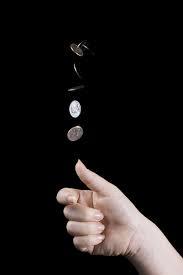Inside two heads
 Consider the following experiment : You are given 4 coins. You toss them simultaneously and you get some sequence of heads and tails.
Consider the following experiment : You are given 4 coins. You toss them simultaneously and you get some sequence of heads and tails.
Then you remove one of the coins and toss the remaining three coins.
Finally remove one more coin and toss remaining two coins.
The probability that in each of these three steps, you get at most 2 heads can be written as b a where a and b are coprime integers. What is the value of a + b ?
I created this problem with the help of my friend Pankaj .
The answer is 205.
This section requires Javascript.
You are seeing this because something didn't load right. We suggest you, (a) try
refreshing the page, (b) enabling javascript if it is disabled on your browser and,
finally, (c)
loading the
non-javascript version of this page
. We're sorry about the hassle.
3 solutions
forgot 0 heads
Let X be the number of heads turn out. Then for step 1:
P 1 ( 0 ≤ X ≤ 2 ) = P 1 ( X = 0 ) + P 1 ( X = 1 ) + P 1 ( X = 2 ) = 1 6 1 + 1 6 4 + 1 6 6 = 1 6 1 1
Similarly, step 2:
P 2 ( 0 ≤ X ≤ 2 ) = 8 1 + 8 3 + 8 3 = 8 7
Step 3:
P 3 ( 0 ≤ X ≤ 2 ) = 1
The three steps together:
P ( 0 ≤ X ≤ 2 ) = P 1 P 2 P 3 = 1 6 1 1 × 8 7 × 1 = 1 2 8 7 7 = b a
⇒ a = 7 7 , b = 1 2 8 and a + b = 2 0 5 .
(0.5 x + 0.5 y)^4 = (x^4 + 4 x^3 y + 6 x^2 y^2 + 4 x y^3 + y^4)/ 16;
(0.5 x + 0.5 y)^3 = (x^3 + 3 x^2 y + 3 x y^2 + y^3)/ 8;
(0.5 x + 0.5 y)^2 = (x^2 + 2 x y + y^2)/ 4;
(11/ 16) else (5/ 16)
(7/ 8) else (1/ 8)
(4/ 4) else (0/ 4)
(11/ 16)(7/ 8)(4/ 4) = 77/ 128 for 205
else 1 - (5/ 16) - (1/ 8) - (0/ 4) = 9/ 16 for 25.
Answer is 205 for each and every steps are successful to achieve (AND Gates).
1 - (99/ 128) - (42/ 64) - (16/ 32) - (5/ 16) - (1/ 8) - (0/ 4) = - 1 - 47/ 128
Since 0 <= P <= 1, 9/ 16 for 25 is a wrong answer of a rush.
1 - P Q R or (1 - P)(1 - Q)(1 - R) are only forms. Not more than 1 OR-linkage. (0.49 x + 0.51 y)^n could be the case and therefore not reasonable to fix as a certain description.
The probability to get k heads out of n coins is 2 n ( n k ) = 2 n ( n − k ) ! k ! n ! .
So, the probability to get 2 or less heads for every time you toss the coin is: 2 n 1 ∑ k = 0 2 ( n k ) .
Finally, if you toss the coin with n = 4 , 3 , 2 coins, the final probability is: ∏ n = 2 4 ( 2 n 1 ∑ k = 0 2 ( n k ) ) = 1 2 8 7 7 .
Hence, the answer is 7 7 + 1 2 8 = 2 0 5